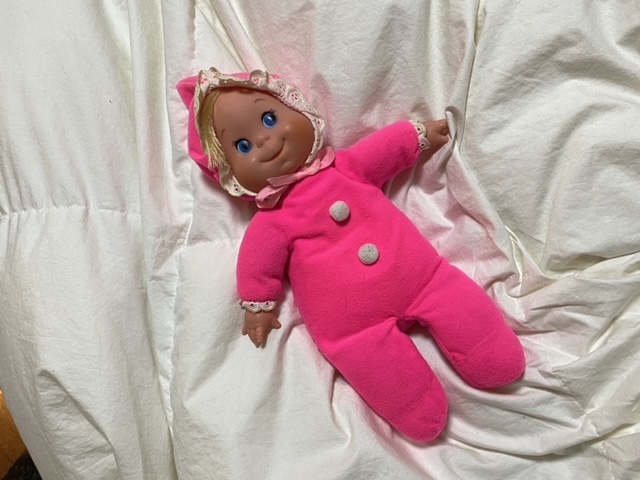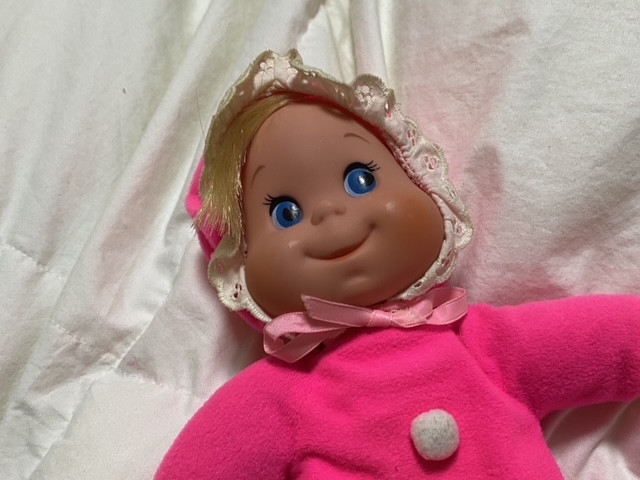Vintage doll with beanbag body: 2,694 ppm Lead (90 is too much), 1,259 ppm Cadmium (40 is too much), + 491 ppm… MERCURY!
Introduction (for those new to this website):
Tamara Rubin is a federal-award-winning independent advocate for consumer goods safety and a documentary filmmaker. She is also a mother of Lead-poisoned children, her sons were acutely Lead-poisoned in 2005. Since 2009 Tamara has been using XRF testing (a scientific method used by the U.S. Consumer Product Safety Commission) to test consumer goods for toxicants (specifically heavy metals), including Lead, Cadmium, Mercury, Antimony, and Arsenic. All test results reported on this website are science-based, accurate, and replicable. Items are tested multiple times, to confirm the test results for each component. Tamara’s work was featured in Consumer Reports Magazine in February of 2023.
May 9, 2021 — Sunday
90 PPM Lead (or higher) is unsafe for kids
The amount of Lead considered unsafe for items intended for use by children and made today is anything 90 ppm Lead or higher in the paint, glaze, or coating, and anything 100 ppm Lead or higher in the substrate. I would not consider this doll safe for use by children today. Most important to know for context: this toy would be illegal if manufactured today.
“But I had a doll like this when I was a kid and I am ok!”
The sentiment expressed in the above quote (or some version of it) is a common refrain, and in response, I wrote an entire article for you to share with parents or grandparents (or spouses or friends) whose lack of concern is based on that notion. Here’s a link to that piece. The fundamental guiding principle that we can all use in a situation like this is “Know Better, Do Better” — why would you knowingly give your child a toxic toy to play with? (Especially a younger child who might put that toy in their mouth!)
“Will my child get poisoned by using this particular toy?”
Strangely, this is a complete unknown — there is no manufacturer that has a financial interest in underwriting research to quantify the potential risk of their historic/ vintage/ legacy products (even though these are products that were often “made to last a lifetime,” and are being handed down through the generations).
There have been several independent studies that demonstrate a basis for real potential concern for toxicants found in vintage plastic toys in general (without identifying specific toys and specific manufacturers of concern). Here’s a link with more information. In my educated opinion, it is simply not worth the possible risk to allow any kid to play with this category of vintage toys incorporating such potentially high levels of multiple neurotoxic metals. There are plenty of modern safer choices available for kids today — and they are normally quite inexpensive. Here’s an affiliate link* to a similar modern doll (it’s actually a set of two baby dolls) that is likely negative for Lead, Cadmium, Mercury, and Arsenic (I have not tested this exact doll set but I trust this brand): https://amzn.to/2R59DlD.
The specific toxicant profile for the doll pictured above
Below are the exact XRF test results for the toy pictured. Please read this article with more information about the testing methodologies used on this website. Note: you cannot do this testing yourself at home (the appropriate XRF instruments are both incredibly expensive and require training and experience to use correctly), which is why I do the testing and report it (free of charge) here on the site so parents have access to this information. If you are interested in having me test an item and report the results on LeadSafeMama.com, please read more at this link. If you have some of the Lead-contaminated items shown on this site, please read this article discussing what you can do with them.
#1) Pink body of doll — 60-second test, reading 1
- Lead (Pb): 1,683 +/- 46 ppm
- Cadmium (Cd): 1,259 +/- 35 ppm
- Mercury (Hg): 452 +/- 33 ppm
- Barium (Ba): 80 +/- 38 ppm
- Silver (Ag): 76 +/- 6 ppm
- Nb: 1,526 +/- 34 ppm
- Palladium (Pd): 63 +/- 5 ppm
- Platinum (Pt): 166 +/- 39 ppm
- Zinc (Zn): 140 +/- 21 ppm
- Copper (Cu): 85 +/- 26 ppm
- Indium (In): 74 +/- 9 ppm
- Vanadium (V): 448 +/- 128 ppm
- Titanium (Ti): 3,667 +/- 334 ppm
#2) Pink body of doll — 60-second test, reading 2
- Lead (Pb): 2,694 +/- 58 ppm
- Cadmium (Cd): 1,213 +/- 31 ppm
- Mercury (Hg): 491 +/- 31 ppm
- Other readings similar to those in the first reading
#3) Plastic cheek of doll — 60-second test
(eyeball of the doll had similar readings)
- Cadmium (Cd): 178 +/- 11 ppm
- Silver (Ag): 19 +/- 5 ppm
- Palladium (Pd): 11 +/- 4 ppm
- Zinc (Zn): 3,246 +/- 121 ppm
- Copper (Cu): 71 +/- 33 ppm
- Indium (In): 45 +/- 10 ppm
- Titanium (Ti): 11,400 +/- 700 ppm
Thank you for reading and sharing this work. As always, please let me know if you have any questions, and I will do my best to answer them personally as soon as I have a moment (which can take a while these days, since there have been so many questions on my website recently — paired with no childcare as a result of the pandemic — so please be patient!).
Tamara Rubin
#LeadSafeMama
Never Miss an Important Article Again!
Join our Email List











For anyone interested, I did some digging and found that this is a baby bean doll. They were made by Mattel in the 1970s.